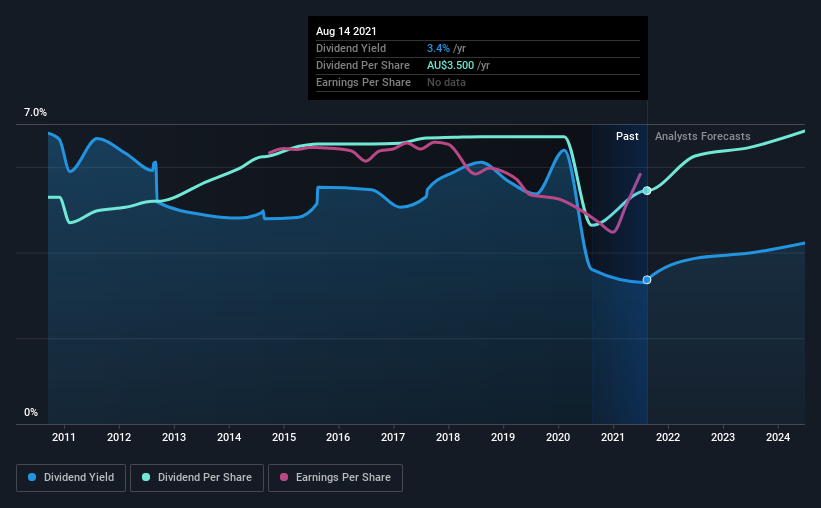Commonwealth Bank of Australia's (ASX:CBA) Upcoming Dividend Will Be Larger Than Last Year's

Commonwealth Bank of Australia's (ASX:CBA) dividend will be increasing to AU$2.00 on 29th of September. The announced payment will take the dividend yield to 3.4%, which is in line with the average for the industry.
Check out our latest analysis for Commonwealth Bank of Australia
Commonwealth Bank of Australia's Earnings Easily Cover the Distributions
While it is always good to see a solid dividend yield, we should also consider whether the payment is feasible. Prior to this announcement, Commonwealth Bank of Australia's earnings easily covered the dividend, but free cash flows were negative. Since a dividend means the company is paying out cash to investors, this could prove to be a problem in the future.
Looking forward, earnings per share is forecast to rise by 22.3% over the next year. If the dividend continues on this path, the payout ratio could be 55% by next year, which we think can be pretty sustainable going forward.

Dividend Volatility
Although the company has a long dividend history, it has been cut at least once in the last 10 years. Since 2011, the first annual payment was AU$3.40, compared to the most recent full-year payment of AU$3.50. Dividend payments have been growing, but very slowly over the period. We're glad to see the dividend has risen, but with a limited rate of growth and fluctuations in the payments the total shareholder return may be limited.
The Dividend's Growth Prospects Are Limited
Given that the dividend has been cut in the past, we need to check if earnings are growing and if that might lead to stronger dividends in the future. However, Commonwealth Bank of Australia's EPS was effectively flat over the past five years, which could stop the company from paying more every year.
The Dividend Could Prove To Be Unreliable
Overall, this is probably not a great income stock, even though the dividend is being raised at the moment. With cash flows lacking, it is difficult to see how the company can sustain a dividend payment. We would probably look elsewhere for an income investment.
Companies possessing a stable dividend policy will likely enjoy greater investor interest than those suffering from a more inconsistent approach. Still, investors need to consider a host of other factors, apart from dividend payments, when analysing a company. Taking the debate a bit further, we've identified 1 warning sign for Commonwealth Bank of Australia that investors need to be conscious of moving forward. Looking for more high-yielding dividend ideas? Try our curated list of strong dividend payers.
If you decide to trade Commonwealth Bank of Australia, use the lowest-cost* platform that is rated #1 Overall by Barron’s, Interactive Brokers. Trade stocks, options, futures, forex, bonds and funds on 135 markets, all from a single integrated account. Promoted
New: AI Stock Screener & Alerts
Our new AI Stock Screener scans the market every day to uncover opportunities.
• Dividend Powerhouses (3%+ Yield)
• Undervalued Small Caps with Insider Buying
• High growth Tech and AI Companies
Or build your own from over 50 metrics.
This article by Simply Wall St is general in nature. We provide commentary based on historical data and analyst forecasts only using an unbiased methodology and our articles are not intended to be financial advice. It does not constitute a recommendation to buy or sell any stock, and does not take account of your objectives, or your financial situation. We aim to bring you long-term focused analysis driven by fundamental data. Note that our analysis may not factor in the latest price-sensitive company announcements or qualitative material. Simply Wall St has no position in any stocks mentioned.
*Interactive Brokers Rated Lowest Cost Broker by StockBrokers.com Annual Online Review 2020
Have feedback on this article? Concerned about the content? Get in touch with us directly. Alternatively, email editorial-team (at) simplywallst.com.
About ASX:CBA
Commonwealth Bank of Australia
Provides financial services in Australia, New Zealand, and internationally.
Excellent balance sheet average dividend payer.


